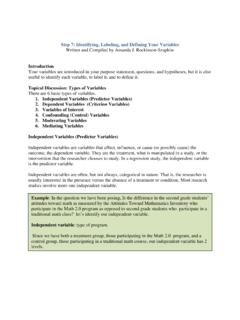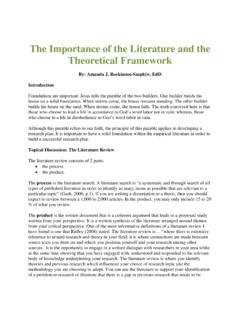Transcription of Step 2: Build a Literature Review and Identify a ...
1 Step 2: Build a Literature Review and Identify a Theoretical or Conceptual Framework Written and Compiled by Amanda J. Rockinson-Szapkiw & Anita Knight Introduction Foundations are important. There is a Biblical parable about two builders. One builder builds his house on a solid foundation. When storms come, the house remains standing. The other builder builds his house on the sand. When storms come, the house falls. The truth conveyed here is that those who choose to lead a life in accordance to God s word labor not in vain; whereas, those who choose to a life in disobedience to God s word labor in vain. Although this parable refers to faith, the principle of this parable applies in developing a research plan. It is important to have a solid foundation within the empirical Literature in order to Build a successful research plan. Topical Discussion: The Literature Review The Literature Review consists of 2 parts: 1) the process, and 2) the product.
2 The process is the Literature search. A Literature search is a systematic and through search of all types of published Literature in order to Identify as many items as possible that are relevant to a particular topic (Gash, 2000, ). If you are writing a dissertation or a thesis, then you should expect to Review between a 1,000 to 2,000 articles. In the product, you may only include 15 to 20% of what you Review . The product is the written document that is a coherent argument that leads to a proposed study written from your perspective. It is a written synthesis of the Literature arranged around themes from your critical perspective. One of the most informative definitions of a Literature Review I have found is one that Ridley (2008) stated. The Literature Review is .. where there is extensive reference to related research and theory in your field; it is where connections are made between source texts you draw on and where you position yourself and your research among other sources.
3 It is the opportunity to engage in a written dialogue with researchers in your area while at the same time showing that you have engaged with, understood and responded to the relevant body of knowledge underpinning your research. The Literature Review is where you Identify theories and previous research which influenced your choice of research topic and the methodology you are choosing to adopt. You can use the Literature to support your identification of a problem to research or illustrate that there is a gap in previous research that needs to be filled. The Literature Review , therefore, serves as the driving force and the jumping off point for your own research investigation. (Ridley, 2008, ) When constructing a Literature Review , you want to ensure that it does the following: Provides context of the study and clarifies the relationship between the proposed research and previous research, both empirical and theoretical Show how the proposed study is unique from previous research Convince the reader that your study is timely and worthwhile Demonstrate your critical ability as a scholar, not your knowledge of others works ( Jones Anderson ).
4 Formulate an argument from your perspective. Make assertions and convince the reader of their legitimacy by providing logical and empirical support. All assertions must be accompanied by empirical support. Your Literature Review should logically lead to your research problem, purpose, and questions, which in turn leads to the identification of your research approach and design. As you provide an overview of the Literature and call attention to the gap that was identified this begins that logical progression. Topical Discussion: Types of Literature (Section written by Amanda Rockinson-Szapkiw and Lucinda Spaulding). As you conduct a Review of the Literature , you need to understand that there are different types of Literature . Literature reviews, meta-analyses, research articles, and theory pieces. Literature Reviews and Meta-Analyses Literature reviews and meta-analyses are both considered Review articles and are similar in many ways: First, they are both conducted for the purpose of integrating and synthesizing the findings from multiple research articles on a specific topic in order to summarize the current state of the Literature on that topic.
5 Both involve conducting thorough and systematic Review of the Literature to Identify all of the studies conducted within a specific time frame addressing the topic of interest. Both publications should provide a list of descriptors or key words used in the search for relevant articles, Identify the search engines or data bases used, and both should provide the span of dates of the publications included, for example, 1975 to 2010. Both should have an extensive reference list of articles reviewed. Where Literature reviews and meta-analyses differ are in the type of articles reviewed and how the findings are presented. We ll start by discussing meta-analyses. Meta-analyses are characterized by the following: Meta-analyses combine statistical results to determine the overall magnitude of findings, therefore, only quantitative research studies are included. The APA requires all single quantitative research studies to report the study s effect size, that is, the magnitude or importance of the study s findings, sometimes referred to as the practical significance of a study.
6 Meta-analyses are conducted by averaging effect sizes from multiple quantitative studies on a single topic to find an overall effect size for a specific intervention or treatment. It s important to note that meta-analyses are used to determine either the strength of an intervention or the difference between two groups. A well known example is the National Reading Panel s meta-analysis comparing phonics to whole language instruction. Sixty-six effect sizes from 38 primary research studies were combined to produce an overall effect size of , which is a moderate effect size in favor of phonics instruction over whole language. If you are lucky and your topic is a well researched one, you may even come across a mega-analysis, which is a meta-analysis of overall effect sizes produced from other meta-analyses! In summary, meta-analyses are your quantitative research reviews, and results are commonly reported in tables. Literature reviews on the other hand, would be considered your qualitative Literature reviews.
7 When an intervention has not yet been evaluated quantitatively or the body of Literature on the topic is still developing, there may not be enough studies to conduct a rigorous meta-analysis. Further, given the topic, the body of Literature may include rigorous qualitative studies that naturally do not generate statistical findings or produce effect sizes. In this case, Literature reviews, also sometimes referred to as narrative research syntheses, or integrative reviews, are needed. These research reviews are characterized by the following: Findings from various research studies both quantitative and qualitative are combined to draw an overall conclusion about findings Generally help to Identify patterns or consistencies across studies Findings are generally described textually and under subheadings. In other words, conclusions about the state of the Literature on the topic are presented in narrative form as opposed to tabular form. So, to broadly summarize, meta-analyses combine statistical findings from strictly quantitative research studies in order to produce an overall effect size, whereas Literature reviews combine findings from both qualitative and quantitative studies and the conclusions are discussed in narrative form.
8 As you search for meta-analyses and Literature reviews, be sure that you are identifying an actual meta-analysis or Literature Review , which means that the findings from multiple studies were systematically and rigorously synthesized. Students often confuse the small Literature Review which is a required section at the beginning of good research studies for an actual research Review . Students also frequently mistake a practitioner oriented article where the authors discuss a specific educational approach or intervention which includes some findings from recent studies to support the teaching approach or intervention and Identify it as a Literature Review . However, these are not rigorous systematic reviews of the Literature but rather explanatory or informational articles geared toward teachers. Remember to look for the elements discussed earlier, such as a list of key terms, search engines, and date spans. A good place to start your search is with the journal titled Review of Educational Research.
9 Research Articles The vast majority of research reports are published in academic journals. The academic journals are most easily accessed through our university library databases. Academic Search Complete, ERIC, and PsyInfo are some of my favorite databases to search when I am looking for research articles on a particular Scholar is another resource that links to articles in our library databases. Let s talk about research articles and how you can Identify them. In research articles, researchers describe how they identified the problem, made relevant observations to gather data, and analyzed the data they collected. The report usually concludes with a discussion of the results and their implications. Research articles have a specific format, and they usually have 5 primary features: The Abstract The Introduction and Literature Review The Methods The Results The Discussion and Conclusion The Abstract An abstract is a summary of the research report.
10 It is usually between 100 to 250 words. APA journals usually specify 240 words or less. A well written abstract for a research article should include the problem under investigations and purpose of the study; the participants and general methodology; the findings, including statistical significance levels; the conclusions and implication or application of the findings. As you can see, the abstract summaries each of the other key features of a research article. You should be able to simply read the abstract and determine whether or not you are reading a research article. The Introduction and Literature Review The introduction and Literature Review sections of the article provide: An Overview of the Problem(s) or Problem(s) Statement(s) o A problem might be defined as the issue that exists in the Literature , theory, or practice that leads to a need for the study (Creswell, 1994, p. 50). A problem statement summarizes the context for the study and the main problem the study seeks to address (Wiersma, 1995, p.)



